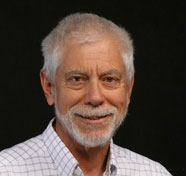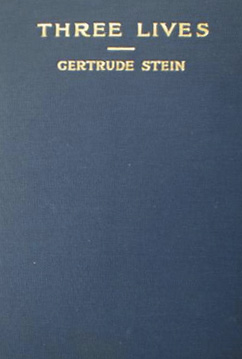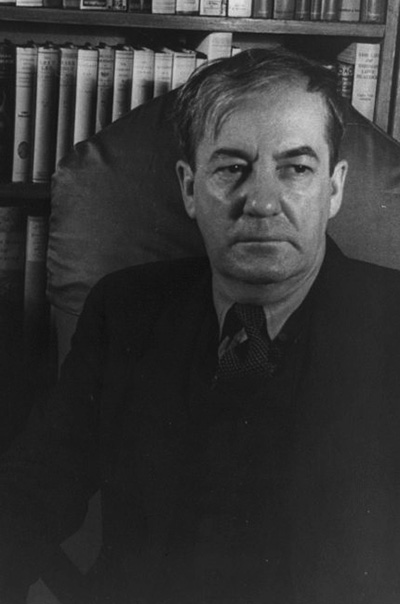

By Robert Wolf
Decorah, IA, USA

Robert Wolf
Mention Gertrude Stein's name to most people and they will reply with words like "obscure" and "silly." Yet what people who make these associations do not know is that Gertrude Stein is the root of modernist American prose and her book Three Lives shaped many future styles. The sentences of Three Lives are unlike later sentences that Stein wrote. They have a seeming clumsiness, which is forceful. Their power influenced the works of Sherwood Anderson and Ernest Hemingway.
Stein's Three Lives came first, then Anderson's Winesburg, Ohio, then Hemingway's In Our Time. Together these works form a triumvirate of early modernist American prose, almost a school of writing. While Stein's work remained obscure for many years, her influence was carried by the writings of Anderson and Hemingway.
To put things in order, let's begin with dates. Stein was born in 1874, Anderson in 1876, and Hemingway in 1899. Stein was a major influence on Anderson, and Anderson and Stein together influenced Hemingway. Hemingway had another great influence, the poet Ezra Pound. I'll mention him later.
Stein had written two short conventional novels before she wrote Three Lives in 1909, when she was thirty-five.

Anderson published two novels in 1916 and 1917 before he published his finest work, Winesburg, Ohio in 1919. Hemingway's In Our Time appeared in 1925.
Anderson was in his mid-thirties by the time he began writing and moved to Chicago, where he became friends with members of the Chicago Literary Renaissance. It was probably in Chicago where Anderson read Stein's first two published works, Three Lives and Tender Buttons, and read them both while writing Winesburg, Ohio.
In 1921 Anderson, by then a famous writer, visited France briefly. At Sylvia Beach's bookshop, Shakespeare & Co, Anderson told Beach his enthusiasm for Gertrude Stein and Beach wrote him an introduction. The relatively unknown Stein and Anderson became friends for life.
That same year, Anderson met twenty-three-year-old Ernest Hemingway at a party in Oak Park. Hemingway and his new bride were intending to live in Rome, but Anderson advised the aspiring writer to head for Paris and wrote him an introduction to Stein.
Stein had written Three Lives in Paris while living with her brother Leo at 27 Rue de Fleurus, famous for the salons Stein and Leo and later Stein and Alice Toklas held there.
In A Moveable Feast, Stein's one-time star pupil, Hemingway, recorded that when they first met "she had published three stories [Three Lives] that were intelligible to anyone. One of these stories, "Melanctha," was very good . . ."

Gertrude Stein
Stein claimed that "Melanctha" was "the first definite step away from the nineteenth century and into the twentieth century in literature." Most likely she made that claim because she knew the language of "Melanctha" and the other two stories made the great departure.
One aspect of that departure came from the restricted vocabulary Stein used to write Three Lives. From Stein, Anderson and Hemingway learned to use simple, Anglo-Saxon words. Hemingway later said, "The old, simple words are the best" and Sherwood Anderson said, "My own vocabulary was small. I had no Latin and no Greek, no French. When I wanted to arrive at anything like delicate shades of meaning in my writing I had to do it with my own very limited vocabulary."
A part of the impetus for Stein's break with traditional structure came from what non-artists would consider an unlikely source. Gertrude and Leo Stein were early collectors of modern European art, and their collection included works by Matisse, Picasso, Braque, Gris, Gauguin and Cézanne. Among their purchases was Cézanne's portrait of his wife. In the Autobiography of Alice B. Toklas (which is actually a memoir), Stein wrote: "It was an important purchase because in looking and looking at this picture Gertrude Stein wrote Three Lives. She had begun not long before as an exercise in literature to translate Flaubert's Trois Contes and then she had this Cézanne and she looked at it and under its stimulus she wrote Three Lives."
Stein claimed that before Flaubert and Cézanne writers and painters had one central idea or theme and all other parts of their work were subordinated to it. This changed when "Cézanne conceived the idea that in composition one thing was as important as another thing. Each part is as important as the whole, and it impressed me enormously." Stein tried to convey this in her writing.
There is much to be said for this claim. The recurrence of words and phrases and ideas in each of the three stories—one of the hallmarks of Stein's style—renders to the whole a certain flatness. In the same way, Cézanne's compositions, built of patches of color (each of nearly equal importance) gives to his works an overall effect of two-dimensionality.

Ernest and Pauline Hemingway
In "The Good Anna," the first of the stories in Three Lives, the servant Anna is a frugal woman, and we are reminded of that throughout the story's 65 pages. "Save and you will always have the money you have saved, was all she could know." Mrs. Lehtmann, Anna's friend, "was diffuse and careless in her ways. . ." and Stein reminds us of that too.
Repetition can come in subtle ways, through synonyms and images. Stein taught Hemingway the value of repetition and a reading of the stories of In Our Time, particularly "The Big, Two-Hearted River," shows him using repetition in very subtle ways. As in the poetry of archaic peoples, repetition adds force and depth to lines and sentences.
Stein had grown up in a family that employed German immigrant servants and knew how they spoke. She used German constructions in "Lena," the final story in Three Lives. By accustoming us to German constructions, she twists them further. It is this "twisting," or using words in new combinations—"Herman was getting really strong to struggle" and "with that always scolding"—that gives added strength to the writing in Three Lives.
I have not read how Stein developed this penchant for unusual constructions, but I think she gives us the key in The Autobiography of Alice B. Toklas. There she informs us that her favorite writers were the Elizabethans, in particular the pamphleteer and playwright Robert Greene. English in Elizabeth's time was without set syntax. All of English was in upheaval: not even names were spelled consistently. Out of this cauldron modern English was born.
I think Gertrude Stein saw that the English of her time was growing moribund, set in its ways, and therefore losing vitality. I think that her transfer of Elizabethan constructions and rhetorical devices was a conscious attempt to revitalize the language. It was not an experiment that either Anderson or Hemingway picked up.

Sherwood Anderson
Three Lives prodded me into thinking about words in combination, about new uses of words, and of unusual ways to express thoughts that we often smother in phrases worn smooth into near meaninglessness. Her work had the same effect on Sherwood Anderson.
Tender Buttons was Stein's first experimental work of the kind that stamped her reputation as a writer of gibberish. There is much of Stein's work that I find incomprehensible and pretentious, but Tender Buttons is not one. The work has no meaning but for writers it has significance. It is divided into three sections, "Objects," "Food," and "Rooms," and each consists of a collection of "descriptions."
Consider, for example, a paragraph titled, "A Drawing." "The meaning of this is entirely and best to say the mark, best to say it best to show sudden places, best to make bitter, best to make the length tall and nothing broader, anything between the half."
When Anderson read Tender Buttons he was led to create his own arbitrary word combinations to see the effects of their interactions. In A Story Teller's Story, Anderson wrote: "How significant words had become to me! How it [Tender Buttons] had excited me! Here was something purely experimental and dealing with words separated from sense—in the ordinary meaning of the word sense—an approach I was sure poets were often compelled to make. Was it an approach that would help me? I decided to try it."
Anderson wrote hundreds of pages of word exercises in the manner of Tender Buttons, and threw them away. During the time he was making these experiments, Anderson visited the studio of a friend, the painter Felix Russman. Russman took Anderson into his studio to show him his paints. "He laid them out on a table before me . . . I shifted the little pans of color about, laid one color against another. . . Suddenly there flashed into my consciousness, for perhaps the first time in my life, the secret inner world of the painters . . . the words used by the tale-teller were as the colors used by the painter."
Links:
Robert Wolf
Free River Press
American Mosaic with Robert Wolf




